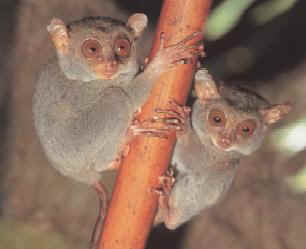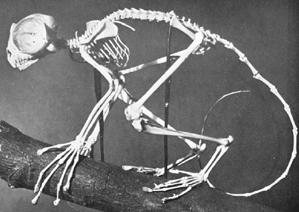
| Palaeos |  |
Primates |
| Vertebrates | Haplorhini |
| Page Back | Unit Home | Unit Dendrogram | Unit References | Taxon Index | Page Next |
| Unit Back | Vertebrates Home | Vertebrate References | Vertebrate Dendrograms | Glossary | Unit Next |
|
Abbreviated Dendrogram
ARCHONTA | PRIMATES |--Strepsirhini `--Haplorhini |--Tarsiiformes `--Anthropoidea |--Platyrrhini `--Hominoidea |--Hylobatidae `--Hominidae |--Ponginae `--Homininae |
Contents
Overview |
Taxa on This Page
Haplorhini: men & monkeys. Defined as tarsiers + Texans
Range: from the Early Eocene.
Phylogeny: Primates : Strepsirhini + * : Tarsiiformes + Anthropoidea.
Characters: short rostrum; tooth comb absent; spatulate incisors; fused mandibular symphysis; upper lip undivided; vibrissae absent; loss of rhinarium; nostrils not separated; $ tapetum lucidum absent [R00]; "fused metopic suture" (??); postorbital septum separates orbits from temporal fossa; $ fovea centralis present {R00]; $ middle ear with anterior accessory cavity if the petrous temporal bone (enhances hearing at low frequencies) [R00]; internal carotid artery; reduced olfactory brain centers; hemochorial placenta present; diurnal.
Links: primate1.html; Haplorhini; primates.jpg; ketal 1997.pdf; Order Primates; Order Primates; Time Based Phylogenetic Classification; human2 (German); r2000.pdf; prosimian BC200 locus JMB.pdf.
References: Ross (2000) [R00]. ATW011028.
 Tarsiiformes : Tarsiers > Texans. Necrolemur, Tarsius.
Tarsiiformes : Tarsiers > Texans. Necrolemur, Tarsius.
Range: from the Early Eocene of Asia, Europe & North America. Molecular phylogenies place the divergence time in the Paleocene, which seems reasonable. Currently limited to Indonesia and surrounding islands..
Phylogeny: Haplorhini : Anthropoidea + *.
Characters: quite small; "dry nose" rhinarium covered with
dry, hairy skin as in anthropoids; rostrum short; complete, hairy upper lip; tapetum
lucidum absent; orbits anterior & closely spaced; eye sockets almost
completely enclosed with bone; eyes are immobile in orbit; retinal fovea
present; ears large; tubular ectotympanic; auditory bulla present and large;
stapedial artery absent; mandibular symphysis unfused; dental formula (living
genus) 2/1, 1/1, 3/3, 3/3; I1 large; lower incisors small; canines large;
grooming tooth absent; head can rotate 180°; humerus with entepicondylar foramen; grooming claw present, but on pes 3 (not 2 as in Strepsirhini);
no opposable digits; tibia & fibula fused over distal 1/3 (leaping
adaptation); tarsals elongate (navicular & calcaneum); hemochorial
placentation; placenta is discoidal & deciduate; nocturnal; feeds on insects
& small lizards & birds (only living fully carnivorous primate); groups
usually consist of mated pairs and their young; territories scent-marked &
announced by vocal duets by both male and female; gestation 180 days with
single offspring; mother transports infant for first few weeks by holding it in
her mouth,  parking
it on a nearby branch while she forages.
parking
it on a nearby branch while she forages.
Notes: [1] most of these characters are for the living genus Tarsius and may not apply to more basal forms. [2] Interestingly, no tarsiiforms have ever been found in Africa.
Image: (right) Tarsius syrichta; (left) skeleton of Tarsius, both from Infraorder Lemuriformes Suborder Strepsirhini Infraorder ... .
Links: Infraorder Lemuriformes Suborder Strepsirhini Infraorder ... (Best on the Web); Tarsiiformes; 2001-1; WORKING GROUP PRIMATE GENETICS Head of Working Group- Dr. Hans ... (one of the few reasonable molecular studies); 7. Fossil primates; Primates as an Adaptive Array; Lecture 19 - Tarsif. & Platyrr.; Fossil Primates 1 (new site? Very nice lecture outline from the Univ. of Leeds); 2001-1 (Beard abstract). ATW030113.
| Page Back | Unit Home | Page Top | Page Next |
checked ATW040213